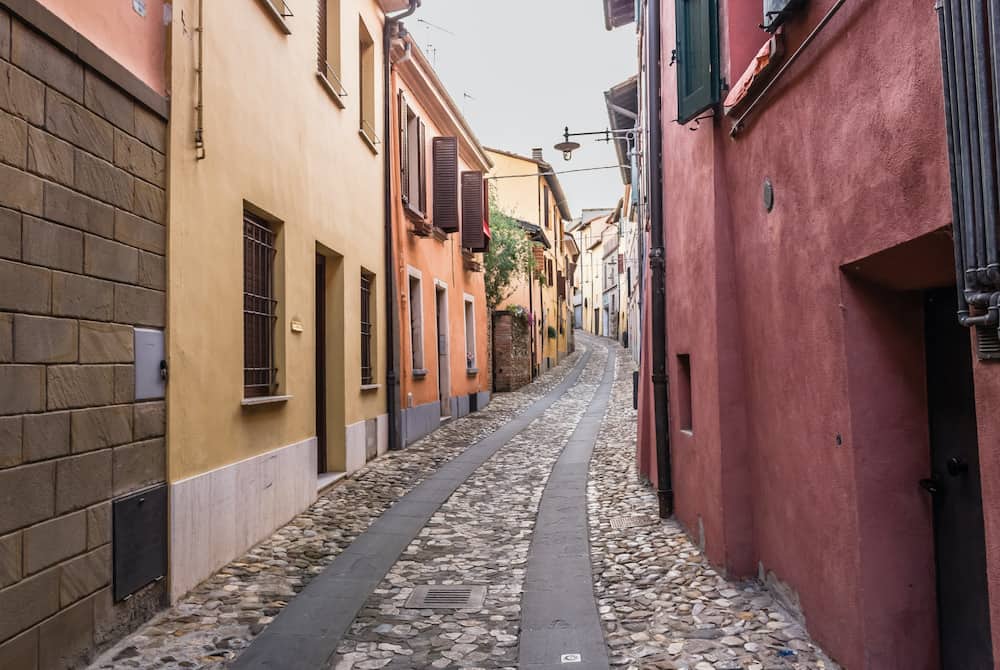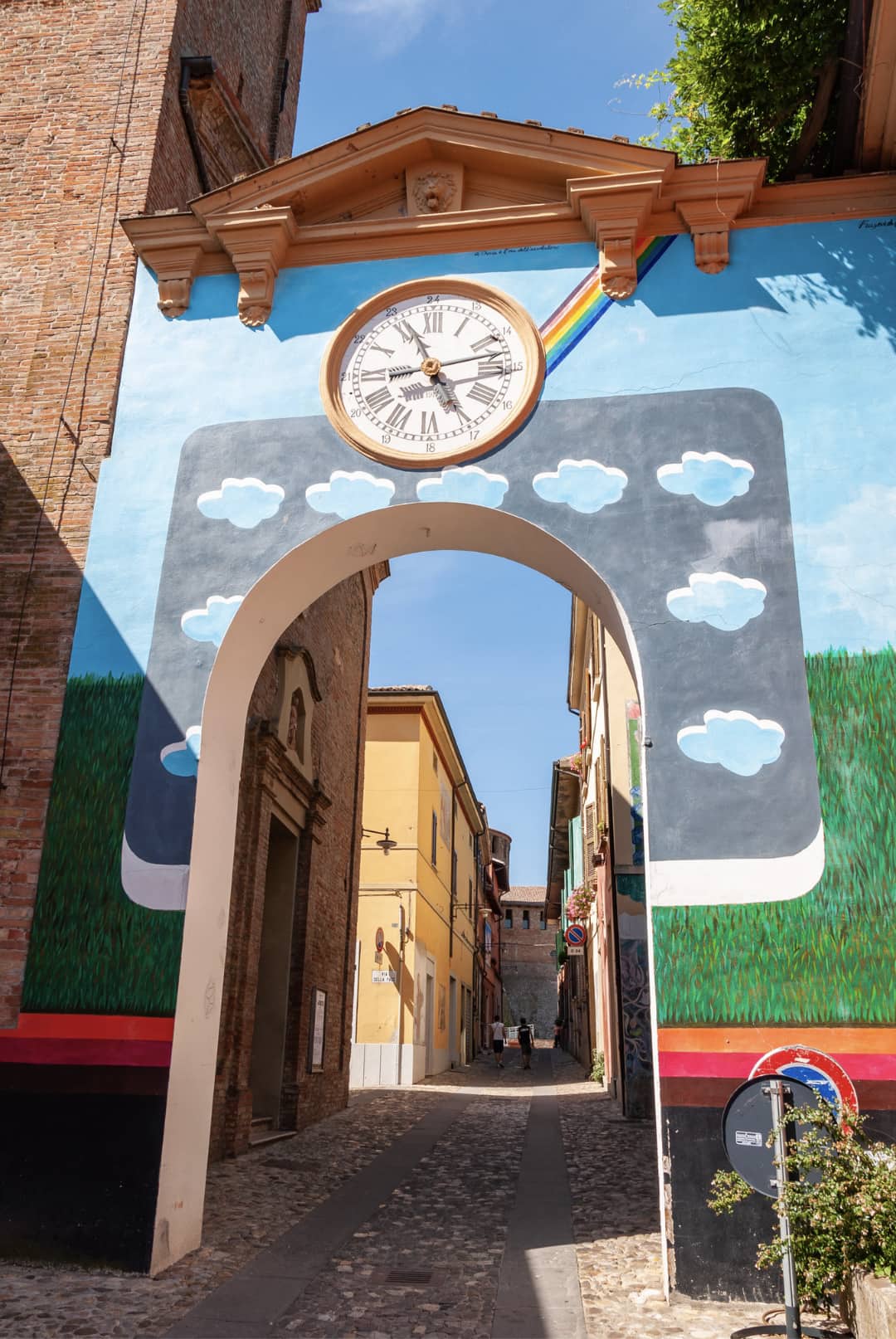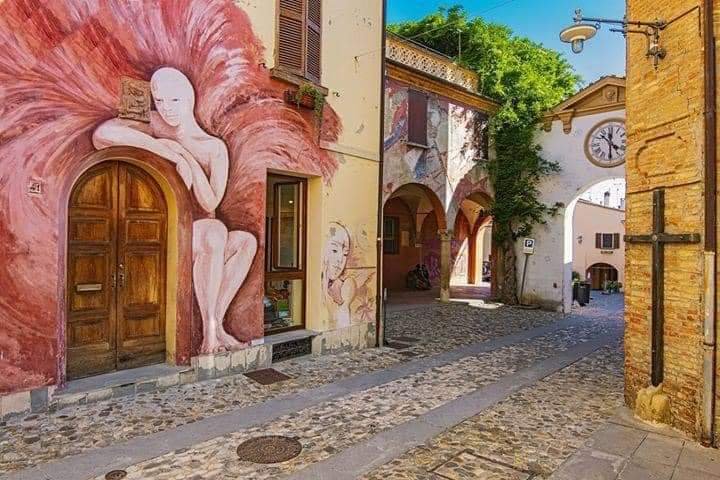Driving is the easiest and quickest way to reach Dozza from Bologna. There is free parking near the entrance to the historic centre. Otherwise, take a train to Imola and then a bus (check ahead for departure information) or a taxi.

Travel tips for a nice excursion

If you're looking for ideas for a last-minute trip out of town, Dozza is your thing. This tiny but lively (and colourful) town, famous for its murals, is a 40-minute drive from Bologna, a fascinating place to spend a day surrounded by art and history. It is a true pearl hidden among the hills of the Tuscan-Emilian Apennines and one of the Borghi più belli d'Italia (most beautiful villages in Italy). Are you curious to find out what to do in Dozza? In our article, we tell you more about this centre of Italian street art.
The Biennial of the Painted Wall in Doza

The Biennial of Painted Wall is a unique event dedicated to the art of painting on the walls of buildings. It began in 1960 and, over the decades, has literally shaped the image of Dozza, making the ancient medieval borgo an innovative and ever-evolving artistic centre. Warnings: watch your step. Tourists walking around looking up at the depictions on the palazzi are a common sight. And it couldn't be any other way. Here, the murals perfectly integrate into the architecture (and history) of the village. Permanent works - take a look at those dating back to the 1960s, and you will be amazed at their excellent state of conservation - created by over 200 Italian and international artists on the façades of the houses.
Since 2007, the district of Toscanella has also been involved in the initiative. In this case, writers and street artists are the real protagonists. The distinctive feature of the festival? The interaction between the public and creatives during the execution of the works. Additionally, the Rocca Sforzesca houses the Centro Studi e Documentazione del Muro Dipinto, the study centre that preserves sketches and some murals snatched off the walls for conservation purposes. There is also a free app that helps you find your way around the murals and learn more about them. Many are the "painted walls" in Dozza, starting with the Rivellino town entrance. On the 18th-century doorway cut into the ancient defensive walls stand out the little blue clouds painted by Alfonso Frasnedi (Arcobaleno, rainbow). Not far away, you will notice a sizeable pink figure "leaning" against a wooden door in Via XX Settembre: this is the Angelo di Dozza by Giuliana Bonazza.
And then you'll meet dragons, imaginative landscapes, anthropomorphic creatures and dreamlike scenes, too: walking through the streets of Dozza is a bit like entering a dream.
Dozza, a village of art and history

Dozza is a "pocket-sized" town: it is small and easy to get around. This characteristic makes it a perfect destination for an impromptu escape from the chaos of the city. You can easily visit it in half a day. It is precisely the compact size and the atmosphere of relaxed vitality that are part of the charm of this village condensed with beauty. Much of the old town is an explosion of colour. Delicatessens, wine bars, artisan shops, churches and historic buildings pop up in an environment soaked in the artworks that make Dozza an open-air gallery in an ongoing evolution. Also, the concept of evolution refers to fluidity and water. Water used to be a scarce and, therefore, precious element. It creeps in the names of some of the historic buildings (the churches of Santa Maria Assunta in Piscina and San Lorenzo in Piscerano) as well as in the origin of the ancient Castrum Dutie. The word "doccia" indicates the presence of a conduit used to collect water in a cistern.
The civic coat of arms itself depicts a gryphon intent on drinking. Dozza was long an "object of desire" for many, given its strategic position on the Via Emilia. The town's history is intertwined with the vicissitudes of the Gauls, Lombards and Byzantines, the disputes between Guelphs and Ghibellines and the cravings of the most powerful families of the Italian nobility. Home to one of the four mediaeval fortresses under the rule of Catrina Sforza, legend has it that the fearless “great lady of Romagne" persists in protecting, unyielding, the halls of her Rocca. Perhaps her ghost is still trying to defeat Cesare Borgia's army, which conquered the fort in 1499. Later, Dozza became a fief of the Malvezzi and Campeggi families.
In 1830 it was a possession of the Papal State, and with the proclamation of the Kingdom of Italy in 1861, it finally became an autonomous municipality. Today, its territory counts just over 6600 inhabitants and includes the hamlet of Toscanella.
Things to do and see in Dozza

Firstly, take a walk through the historic centre and its artistic alleyways, possibly sipping some good wine, the pride of local production. As already mentioned, Dozza is a small village, and once you have parked your car, you will be able to sightsee in a few hours. Murals aside, here are the main attractions you should not miss. Like all medieval towns, Dozza also has its stately castle, and what a castle! The 13th-century Rocca Sforzesca is a well-preserved structure that still shows off its original furnishings (from Renaissance to Baroque).
Over the centuries, the building went from being a purely military structure to a noble palace. You can visit aristocratic rooms, a small art gallery and kitchens equipped with fires and 16th-century utensils. Drop in the prison cells, still macabrely marked by the inscriptions of prisoners, and enter the torture and weapon rooms. Also, the guard walkways overlook the beautiful valleys and vineyards surrounding Dozza. Inside the Rocca, the Enoteca Regionale Emilia Romagna offers a permanent exhibition and tasting activities, plus a rich and evocative vaulted cellar. Together with the wall paintings, wine is another distinctive feature of Dozza: Albana, the first Italian DOCG white wine, was born amid these hills.
Continue your exploration by reaching Santa Maria Assunta in Piscina. In the 12th-century church, you can see a 1492 painting of the Madonna and Child between St John the Baptist and St Margaret by Marco Palmezzano. Palazzo Comunale is very close by and reveals a stunning view over the Emilian countryside. Its Historical Archive preserves documents and parchments dating back to the 10th century. Also worthy of note is the parish church of San Lorenzo, the convent of Monte del Re, a 13th-century building now turned into a hotel, and the sanctuary of the Madonna del Calanco.
The latter dates back to the 1600s and houses the miraculous bas-relief of the Beata Vergine del Calanco carried in procession during Dozza's patronal festival. Before leaving, get to the panoramic Via S. Anastasia for a last, scenic farewell to the borgo and the magnificent Valsellustra.
About the author
Written on 03/10/2021



Lorena Calise
Dozza, a medieval borgo in the Emilia-Romagna region, came up with a creative way to draw visitors in the 1960s.